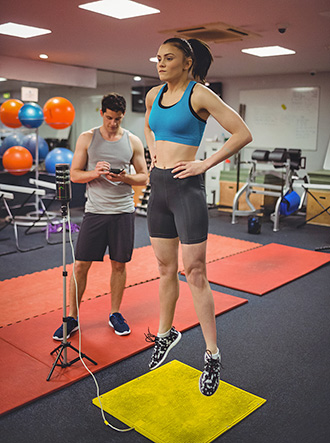Measuring vertical jump ability for leg power assessment is not necessarily a simple process. There are many jump techniques, measurement methods and equipment variations. All these can affect the results, reliability and interpretation of the test.
Squat Jump or Static Jump
In its simplest form, the vertical jump test is performed as a squat jump or static jump. In this technique, the subject starts from a stationary semi-squatting position, or pauses at the lower level of the squat before jumping upwards. This removes the factor of the stretch-shortening cycle (pre-stretching of muscles) and the jump result will be smaller than other techniques described below. The difference in jump height is typically 3-6 cm without a countermovement. Example: Squat Jump
Countermovement Technique
The vertical jump test is commonly performed with a counter movement, where there is bending of the knees immediately prior to the jump. The countermovement activates the stretch-shortening cycle in the muscles, resulting in greater power production in the legs. Without the use of the arms, it makes it difficult to use the traditional technique of reaching up and touching the wall. The eTID VJ protocol is a countermovement test performed with no arm swinging, though the test is performed with one hand on the hip and the other raised above the head so as to reach up the wall. The Bosco Countermovement Jump test is performed on a touch sensitive mat, so the arms can be left on the hips throughout the jump.
 Using the Arms
Using the Arms
Using the arms during a vertical jump test is not always desirable, as it add variations due to technique and coordination, though most vertical jump tests you will see performed allow the use of the arms to help propel the body upwards, as well as a countermovement. Greater jump heights can be achieved with this method. In fact some measurement techniques are hard to conduct without the arms swinging, as they require that the arm is extended upwards to mark the wall or the vanes of the Vertec® can be hit. See the general vertical jump test description which gives the procedure for this method. Also see the Abalakov Jump Test, an example of the vertical jump using both arm movement and countermovement using a jump mat.
Other Variations
Standing vertical jump tests can also be performed off one leg to isolate that side of the body. There are also a few vertical jump test protocols that allow a run up. There is a version with one step into the jump, or with a run-up and taking off one or two feet, depending on the relevance to the sport involved. Another version used in basketball testing, the Max Touch, does not specify one or two leg takeoff, just jump as high as you can! Bosco has described a series of vertical jump tests, including those with an extra load on the shoulders, after dropping from a box and multiple repeated vertical jumps. You can read more about the Bosco Jump System.
Measurement Methods
In addition to the different jumping techniques, there are also several methods to measure the vertical jump, such as:
- using a timing mat or force plate or video — by measuring flight time.
- using a Vertec® or similar apparatus — measuring reached height.
- against a wall — simple traditional method.
Equipment
There is much more about the various vertical jump equipment that is available.
Related Pages
- Vertical Jump test results.
- Vertical jump equipment and measurement methods
- Vertical jump devices in the fitness testing store.
- Poll: Which equipment do you use to measure vertical jump?
- The Bosco Jump System.


 Current Events
Current Events